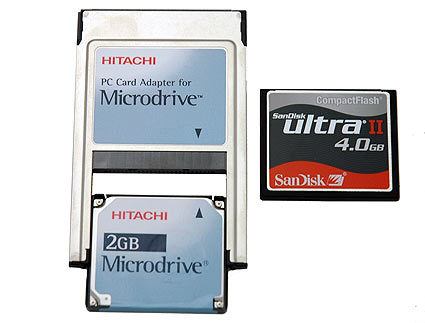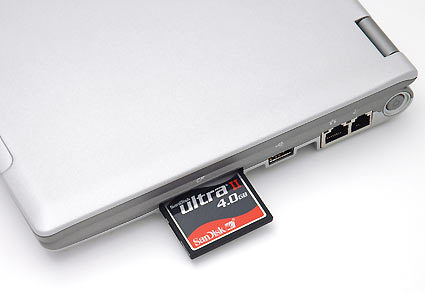When Size Really Matters: Smallest Flash Cards
Too Big? Compact Flash
The compact flash format is the most technically flexible type: it supports the highest data transfer rates (up to 30 megabytes per second) and highest capacity (up to 8 GB, with further increases clearly in sight). Version 3.0 provides transfer rates up to 66 megabytes per second. Already-defined specifications permit speeds as high as 137 gigabytes per second, or as slow as 16 megabytes per second. Compact flash also works with either 3.3 or 5 V, further enabling flexible use and a variety of implementations.
The CF interface uses 50 pins, but is nevertheless compatible with PCMCIA-ATA. This is in remarkable contrast to other standards that CF quickly vanquished in the marketplace. PCMCIA-to-CF adapters are simple to implement (see the next photo). Easy ATA-compatibility results from the lucky coincidence that CF cards use the same controller that ATA devices also use.
There are several types of CF cards, which vary in size, to enable other uses besides memory-based storage devices. Compact Flash types I and II may be distinguished by their thickness: 3.3 and 5.0 mm (Hitachi's Microdrive is simply too big to fit inside a 3.3 mm envelope). Other possible CF applications include modems or network interfaces, Wi-Fi or Bluetooth adapters, and scanners or graphics processors.
Compact Flash versus PC card or Express Card? I/O devices in CF format are conceivable, no technology innovation needed. For example, Dell's ultralight Latitude X1 notebook offers CF and SD slots, but no PC Card slot!
Get Tom's Hardware's best news and in-depth reviews, straight to your inbox.
Current page: Too Big? Compact Flash
Prev Page Flash Memory: Here's How It Works Next Page Small: mmC And SD
Patrick Schmid was the editor-in-chief for Tom's Hardware from 2005 to 2006. He wrote numerous articles on a wide range of hardware topics, including storage, CPUs, and system builds.

